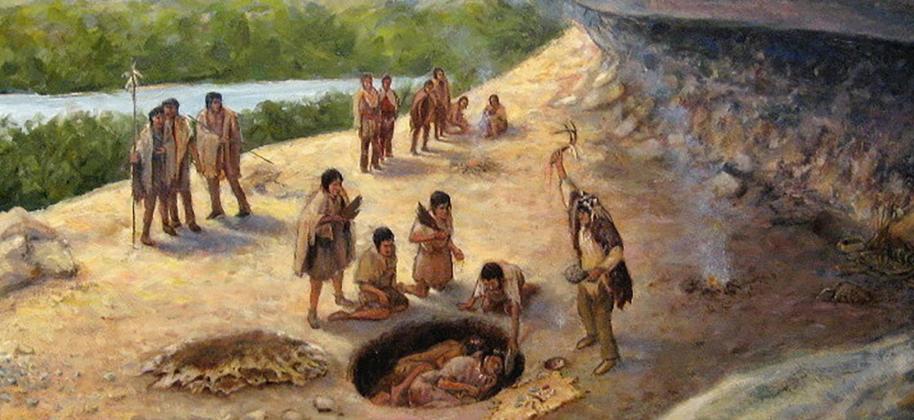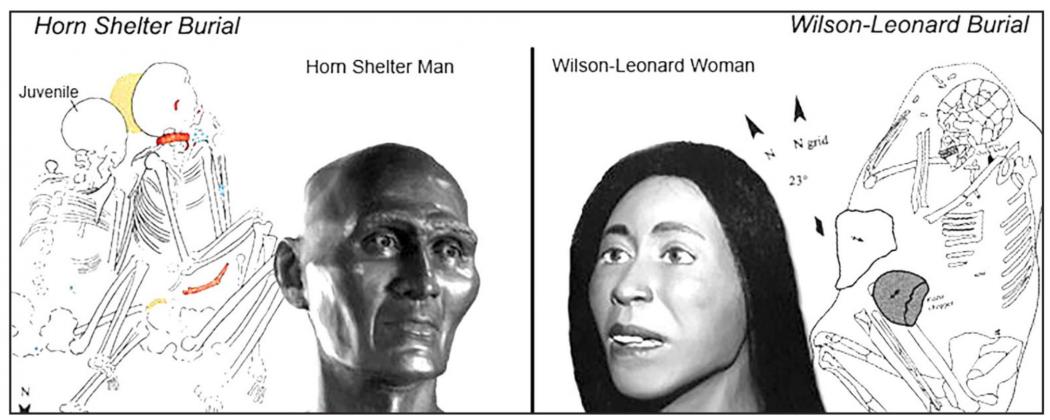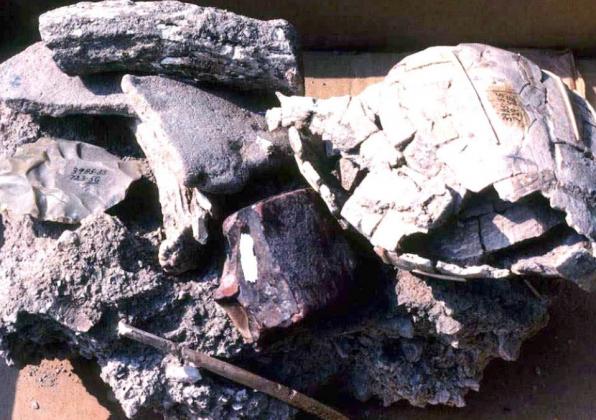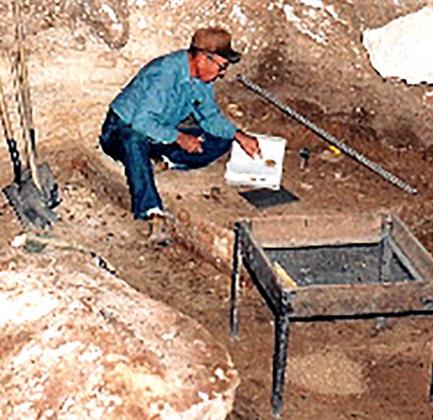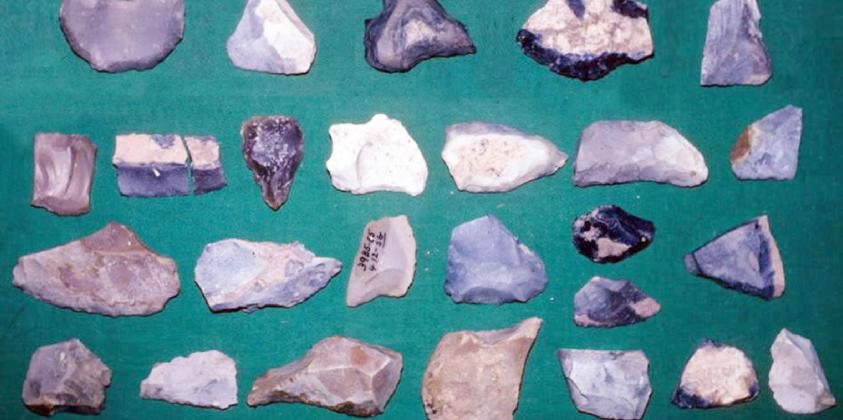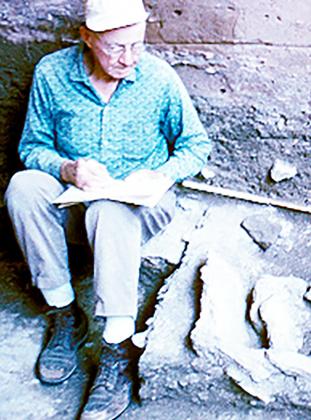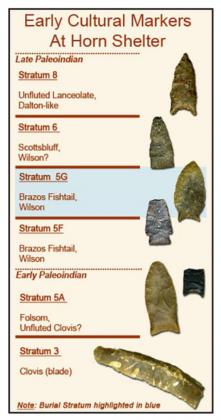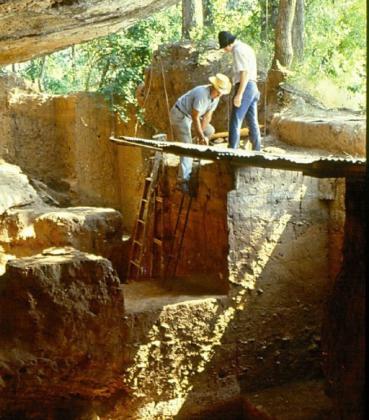New Museum Horn Shelter exhibit planned
Burial ceremony at Horn Shelter, about 11,000 years ago. A group leader wearing a badger headdress shakes turtle shell and deer antler rattles as members of the funeral party place special items within the grave of the man and child. Although many aspects of this scene are based on actual archeological evidence recovered from the site, it is not intended to be an exact reconstruction of the event, but rather one plausible interpretation of what took place in the past. The Bosque County Museum plans to build a 600 square foot exhibit for the burial site that was discovered 50 years ago. Painting by Frank Weir | The Clifton Record Grave maps from Horn Shelter, left, Wilson-Leonard, with facial reconstructions of Horn Shelter man and Wilson-Leonard woman. The interred individuals at both sites had been placed in semi-flexed position with faces directed approximately toward the west. These rare, early graves are close in time and geographic location. The Wilson-Leonard site is in Williamson County, roughly 100 miles (160 km) from Horn Shelter. Both graves contained funeral offerings, although the numerous special items laid with Horn Shelter man suggest he was a revered leader or person of power. Drawings by Frank Weir | The Clifton Record Grave items from the burial site of an adult male at Horn Shelter, including nested box turtle shells, antler tools, sandstone slabs, chipped-stone biface, and red ocher nodule. Photo by Albert Redder | The Clifton Record Albert Redder at work in the south end of the shelter. The excavators screened the sediments they dug out and systematically documented their work in notes, maps, and photographs. Courtesy Photo | The Clifton Record Examples of the numerous and diverse unifacial tools from Horn Shelter Sub-Stratum 5G. A diverse assortment of other campsite remains were found in this dark midden layer including other tools, weapons, and animal bone. Courtesy Photo | The Clifton Record Frank Watt maps the stone slabs covering the Paleoindian grave prior to its excavation. A lithographic engraver by trade, Watt was an accomplished artist in the field.. Photo by Albert Redder | The Clifton Record Idealized graphic of representative diagnostic projectile points and tools from selected Paleoindian strata at Horn Shelter. Not shown are points from Stratum 7, including Brazos Fishtail, possible Wilson, and other notched, stemmed points. This deposit outside the shelter overhang likely correlates to Stratum 5 in the interior. Courtesy Photo | The Clifton Record Albert Redder at Horn Shelter, ca. 1970. Over the past 40 years, he has logged thousands of hours excavating the south end of the site and analyzing the evidence. Photo by Calvin Smith | Meridian Tribune
The Bosque County Museum will be renovating the Horn Shelter exhibit.
One of only 14 Paleo-Indian burial sites in America, Horn Shelter No. 2 burial site exhibit it Bosque Museums is one of their main attractions and will be getting almost a quarter-million-dollar update for the 50th anniversary of it’s discovery.
“This has been an existing exhibit, but we feel like we need to make it more interactive for a better visitor experience and also update some of the science behind it,” said Bosque County Museum Board of Trustees President Patricia Ferguson.
“There has been more testing done and more exact dates, so we thought it would be a good idea because it is like a centerpiece of the museum and a treasure we have here in Bosque County that not many folks don’t know about.”
According to the Texas State Historical Association, the archeological site known as Horn Shelter No. 2 is on the west bank of the Brazos River between Waco and Lake Whitney. It is a rockshelter formed by erosion in Cretaceous limestone and is 150 feet long and up to 30 feet wide that opens toward the east and is 60 feet from the river. The bedrock floor is about 15 feet above the normal river level as 22 feet of stratified fill has accumulated under the shelter.
Excavation in the south end began in the spring of 1966 by those who discovered the site, Frank H. Watt and Albert J. Redder of Waco. Robert E. Forrester and L. T. Francis of Fort Worth began work on the north end in the fall of 1968. By the fall of 1990 the excavation had been completed, and as of 1995 no further excavations had been conducted since that time.
The excavators dug through nearly 20 feet of deposits,and mapped 27 layers, or strata, finding flint, split animal bones, and fire hearths that showed a record of a varieties of human occupation from Paleoindians of at least 10,000 years ago to the Prohibition period of the 1930s.
The earliest identified culture at the site is the Folsom, a native culutre that existed more than 12,000 years ago, that was identified by three Folsom points. Although, a large, still unidentified dart point was found slightly deeper than the Folsom.
Above the Folsom and separated from it is a point type defined by Watt as the Brazos Fishtail. Most archeologists consider these to be San Patrice. Above this is a Plainview occupation. Later than the Plainview is an Archaic period stratum overlain by a deposit of Late Prehistoric artifacts. By A.D. 1410 the whole shelter was capped with a three-foot-deep red sand deposit, part of which was later removed by whites who subsequently lived in the shelter.
“It’s a unique and rare site because it’s the only Paleo-Indian site of a double burial that was excuvated 50 years ago,” Ferguson said. “One was a man believed to be of high prominence in the community that dates back more than 10,000 years and he has hundreds of artifacts like tools.”
At thr Paleo-Indian deposit was a burial of two individuals, an adult male and a juvenile, interred together in a shallow grave and covered with soil and stone slabs.
It’s the only double burial of Paleo-Indians that currently exists, making it unique in the world.
Under the head of the adult was an array of grave offerings-seashell beads, turtle carapaces, flintknapping tools, red ocher, small slabs of sandstone, flint, and perforated canid teeth. The only artifact found with the juvenile was a small-eyed bone needle.
Radiocarbon assays from this stratum have yielded dates of 9,500±200 years B.P. to 10,310±150 years B.P. Charred bones found around hearths under the shelter indicate a heavy dependence on small game, though bison bones have been found in deposits in front of the shelter.
Judging from the camping debris left over the millennia, the Paleoindian peoples of Horn Shelter periodically hunted these bison and deer, but clearly depended upon a wide variety of much smaller animals for food that they cooked on small, rockless fires built directly on the ground.
By 1983 forty different dart-point types had been identified from a total of more than 1,000 points recovered. A preliminary evaluation indicated that most of the points belonged to the Central Texas Archaic, though some materials were indicative of East Texas Archaic cultures.
Other Archaic materials included bone fishhooks, flaking tools, and awls; red and yellow ochre; manos; metates fragments; scrapers, drills, and bifaces; sandstone paint grinders; and needle hones.
The top of the Archaic stage and the beginning of the Late Prehistoric was not demarked by visible stratigraphy. A number of dart points of various types were found at this level. The most recent Indian occupation at Horn No. 2 bore evidence of the Toyah horizon and was dated by charcoal radiocarbon at A.D. 1410±130.
“The originals are held by the Smithsonian, but we have duplicates of these artifacts that are being used in our exhibit,” said Ferguson.
The Bosque County Museum is contracting the Dallas-based company Museum Arts to redo and build the new 600 square ft interactive exhibit.
“There will be interactive touch screens and updated striation maps to show where the burials were in the soil,” Ferguson said. “The site map is by Mr. Redda.”
The Clifton Economic Development Committee met last week and approved a suggestion that the city council loan the museum $30,000 on 5-year loan at no interest to the to complete their funding needs.
“We’ve raised $224,000 to date for the exhibit,” Ferguson said. “We need 30 to 50 thousand for the full install more because we want to also features 3D likenesses of Redder and Watt.”
The museum was also hoping to use the additional $30,000 for staffing so the museum can extend its hours to be open on Sundays and to make modifications for rewiring inside the museum.
Construction on the exhibit is scheduled to be completed by the begging of August and a ribbon-cutting for the exhibit planned in October.
“It’s the only double burial of Paleo-Indians that currently exists, making it unique in the world.”

